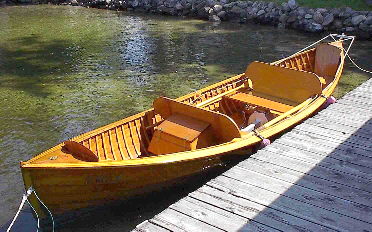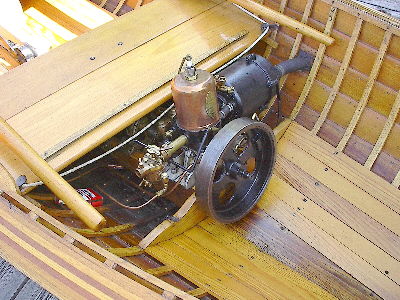| Author |
Message |
    
Glen Diggins
Visitor
| | Posted on Thursday, January 05, 2006 - 02:50 am: | 




|
This engine has a brass schebler carburator and a nickle plated connecting rod off the crank to the water pump and a beautiful script makers plate. It has a wipe spark. It is a single cylinder engine that is approximately two feet high. The flywheel is approx. 11". Very good condition. High compression, and a real show piece. Question is: Any suggestions as to what it is worth? |
    
andrew
Moderator
Username: andrew
Post Number: 1317
Registered: 11-2001

| | Posted on Thursday, January 05, 2006 - 08:16 pm: | 




|
Glenn,
It sounds like an interesting engine. What exactly does it say on the nameplate?
If you post some pictures here some of the regulars might be able to give you some very useful information and history on the engine... but "what's it worth" is a topic we try to avoid. You can look on our classifieds and other print or online classifieds and auctions to get an idea on prices.
If you have trouble posting pictures you could email them to me or any of the regulars on this site. |
    
whiteox_3
Member
Username: whiteox_3
Post Number: 4
Registered: 11-2004
| | Posted on Sunday, January 08, 2006 - 04:42 am: | 




|
Hi! I have installed a Chinese 3.5 hp diesel water cooled motor in a old 16 ft aluminiun flat bottom boat. The noise and vibration is driving me nuts. The vibration I can live with,but can some one tell me about wet exhaust? Is it something a handy man can make? and how does it work? thanks Don |
    
miro
Senior Member
Username: miro
Post Number: 202
Registered: 11-2001
| | Posted on Sunday, January 08, 2006 - 10:49 pm: | 




|
Putting a wet exhaust will certainly quiet things down.
THe idea is to inject the water from engine cooling into the exhaust pipe, as close to the engine as you can get it. What I have done is to get a 1 1/2 in black iron 45deg elbow and drill an angled hole into which I put a 1/2 in pipe. The pipe injects the water into the exhaust stream. You must make everything go downhill and point downhill. After that you can use ordinary pipe to take the water and exhaust out of the boat and overboard. Make sure that it is ABOVE the waterline.
The fewer the bends, the better.
You'll find that with these engines, there is enough cooling that you can put your hand on the downstram pipe with no problem.
If the darned water wasn't frozen solid up where I have my oats, I'd send some pics.
You might also consider a wet muffler.
Ironically, my DisPro has a muffler ( 3 hp, 1 cylinder engne) and my inboard ( 4 cylinder 20 hp) has no muffler). In both cases, pleasant conversations at normal speech levels during cruising are the result.
miro |
    
whiteox_3
Member
Username: whiteox_3
Post Number: 7
Registered: 11-2004
| | Posted on Monday, January 09, 2006 - 06:14 am: | 




|
Miro in my post i was not clear enough as the little chinese motor has a boil away tank you add water as it boils down so I might not be able to make it wet . Miro here is another dumb question . I am redoin up a old fiberglass bertham 14 ft I want to put in a diesel marine motor I can buy a 60hp.or a 30hp. they both weigh around the same 300 kg an rev at 3000 rpm
will i get more speed with the 60 or is it torq speed is not the isue as I will mostly be trowling my gut tells me the smaller might be the go thanks don |
    
miro
Senior Member
Username: miro
Post Number: 203
Registered: 11-2001
| | Posted on Monday, January 09, 2006 - 01:21 pm: | 




|
Heck, with a 14 ft boat, you could get away with 10 hp, slow speed.
My DisPro is 18 ft and moves quite well with 3 hp at 900 rpm.
The formula for HP is Torque x speed. Most torque vs speed curves are quite flat, i.e. torgue does not vary much with speed.
The terminal velocity of your hull is probably aboiut 5-7 mph. With a 12 in. dia. propeller, you'd need about a 12 in pitch at about 1000 rpm ( just above idle speed).
After you reach the terminal hull speed, the HP requirement becomes huge. You end up burning a lot of fuel for very little improvmenet in speed,
e.g. to get the hull to 10 mph, you'd probably need the 60 HP at full throttle.
I think the 30 hp is more than enough. You'll certainly get much better fuel ecomony.
The thing that will determine how much you enjoy your boat is the propeller. 3 blades are much better than 2 (less vibration and less loading of the blade surface - prevents cavitation)
Miro |
    
whiteox_3
Member
Username: whiteox_3
Post Number: 8
Registered: 11-2004
| | Posted on Monday, January 09, 2006 - 10:30 pm: | 




|
miro thanks for all the info. now here ar my choices I can install 3.8 hp new aircooled. this motor is in my shed I have paid us 90.00 for. also a 20hp aircooled 2 cyl v type motor for Us 680.00 plus 150.00 shiping also a 10 hp air cooled about the same price. All are with out gear boxs as far as fuel I get this back gkw.hr 275/ 287 and i havent got a clue what they are talking about. Am going to try to send attachment of 20 hp Don
--------------------------------------------------------------------------------
|
    
miro
Senior Member
Username: miro
Post Number: 204
Registered: 11-2001
| | Posted on Tuesday, January 10, 2006 - 02:09 pm: | 




|
I think they are talking about the amount of fuel per KW-hour or gallons per HP hour.
The conversion is 1 HP = 0.75KW
So , you get 0.75 x 275 gal per HP-Hour
If you run a 10 HP engine for 5 hours, you have 50 HP-hours. According to this , you will consume
0.75 x 275 / 50 gallons or 4.1 gallons of fuel.
miro |
    
whiteox_3
Member
Username: whiteox_3
Post Number: 9
Registered: 11-2004
| | Posted on Wednesday, January 11, 2006 - 04:34 am: | 




|
Miro you are the best! Have you ever been stumped? What size shaft is in the dispro? and what gear box ? As I have now decided to install the 3 hr all my fishing is in protected water and I do not need the speed. My problem will be a gear box. it seem they are hard to find over here in ozzie land the restI hope to find on ebay or boat wreckers. Miro do you have any pictures of the dispro? an thanks for all the help Don |
    
miro
Senior Member
Username: miro
Post Number: 207
Registered: 11-2001
| | Posted on Thursday, January 26, 2006 - 09:17 am: | 




|
The Dispro has a 3/4 in dia shaft. It is direct drive - you start it and you go. I am woring on restoring abother , slightly older boat ( 1910) witha Gray - that shaft is 1 1/4 in dia. I thenk that would be about as big as you need.
You can see the DisPro mechansim at
www.dispearingpropllerboat.com
If you are not planning to move fast from your dock, I don't think you need a gear box ( i.e a reverse gear) - a clutch will be OK - you'll simply have to get use to manoeuvering it with fwd or netral only.Gear boxes take up precious horsepower for these low HP engines.
Here are 2 pictures of my DisPro.
Miro
The hull is cypress and is quite original including all of the hardware and engine from 1926

The engine has a recoil start operated from the middle seat position which is nice, since you go when you start the engine - at least you can se where you are headed.
 |
    
thomas
Senior Member
Username: thomas
Post Number: 323
Registered: 07-2002

| | Posted on Thursday, January 26, 2006 - 06:42 pm: | 




|
Miro, Is that recoil starter like about a 4 or 5" drum with grooves and a steel cable wound around it with ratchet? I have a Dispro that I'm hoping to display some day all set up with a section of the hull, dispro unit etc. My engine came with that kind of a starter. |
    
miro
Senior Member
Username: miro
Post Number: 208
Registered: 11-2001
| | Posted on Friday, January 27, 2006 - 04:18 pm: | 




|
Yes- that is the starter used on the copper jacket engines. My boat is all buttoned up for the winter in a boat house which probably encased in 4 ft of snow.
I'll see if I have other pictures of the starter somewhere. There may be pictures on the www.disappearingpropellerboat.com webs site that has pictures of the starter - have a look at Dorrie Ann and the Caron.
The DisPro Owners Association ( DOA) use to have someone with a cut away hul with a copper jacket engine - dunno what happened to that - will try to find out.
Miro |


